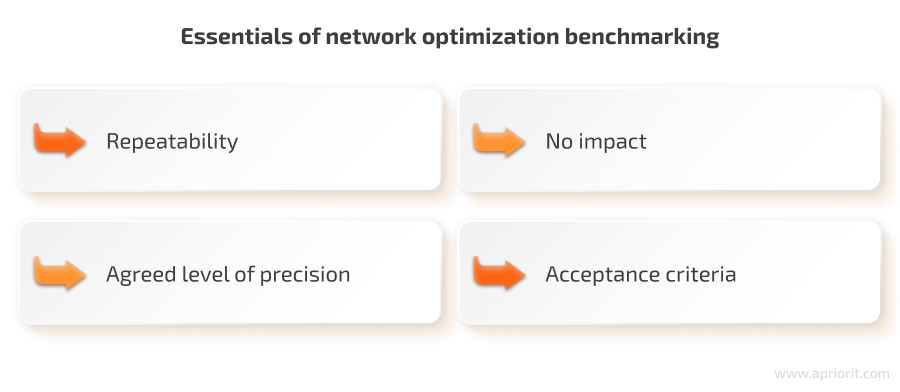As companies rely more and more on connected systems, cloud services, and real-time data exchange, network optimization has become essential to maintaining a competitive edge. Limited performance, data bottlenecks, and inefficiencies in your networks can lead to downtime, frustrated users, and missed opportunities. This is why you need to make sure that your networks operate smoothly.
In this article, we explore the basics of network optimization, including ways to detect and resolve common performance bottlenecks. You will learn advanced strategies from Apriorit’s expert engineers, who can help you achieve a high-performing network tailored to your business needs.
This article is designed for technical decision-makers, IT managers, and business leaders seeking to resolve existing issues or future-proof their networks.
What is network optimization and why does it matter?
Network optimization is the process of enhancing a network’s performance, efficiency, and reliability. By gaining visibility into how data moves through the network, businesses can detect and resolve issues before they escalate into bigger problems. Network optimization also helps businesses maintain high performance even as their operations grow, making sure that data is transmitted quickly, securely, and without interruptions.
So, why is network optimization important? Here are some of the key benefits of implementing this process into your operations:

- Increase data transmission speed. Optimized networks can significantly reduce latency and packet loss, leading to faster data transfer and fewer disruptions.
- Enhance the user experience. A well-optimized network guarantees consistent and high-quality performance, leading to a better experience for end users, especially in applications like video streaming, online services, and cloud-based platforms.
- Support business scalability. As businesses grow, their networks need to handle increasing amounts of traffic. Optimization ensures a network can scale up and down effectively, accommodating expansion without degrading performance.
- Strengthen security. Performance bottlenecks can create opportunities for security vulnerabilities. Optimizing network performance minimizes these risks, making sure that data is transmitted securely and efficiently.
To optimize a network effectively, you need to understand how its performance is measured. Key network performance metrics provide insights into a network’s health and efficiency, helping your team identify areas for improvement. Let’s see what these metrics are.
Struggling to maintain stable network performance?
Enhance your system’s efficiency with Apriorit’s network management services. We’ll help you monitor, manage, and optimize your network for smoother operations and faster growth.
Top metrics to monitor for optimal network performance
You can evaluate the performance of your network by tracking a set of metrics that indicate how efficiently data is being transmitted and received across the network. Here are the most important network performance metrics to measure:

- Throughput is the rate of successful data transfer over a communication channel. This metric tells you how much data is being transmitted successfully over the network in a given time frame.
- Latency is the time it takes for data to travel from one point to another. Latency is crucial in real-time applications such as VoIP and online gaming, where delays can negatively impact the user experience.
- Packet loss is the percentage of data packets that fail to reach their destination. Packet loss causes retransmission and degrades overall network performance, particularly in applications that rely on a continuous data flow, like video streaming and conferencing.
- Jitter is variability in packet arrival times. High jitter is problematic for real-time applications, as it can cause an uneven data flow, affecting quality. Low jitter is critical for maintaining smooth communication in services like voice and video calls.
- Bandwidth use shows how much of the available bandwidth is being used. Proper bandwidth utilization makes sure that the network is not under- or over-utilized, which could lead to inefficiencies or congestion.
These metrics can be collected using various network monitoring and profiling tools. Let’s take a closer look at them.
Useful tools for network profiling and optimization
The specific tools and technologies required will vary based on your project’s unique characteristics. However, based on our experience, the following tools are commonly used for profiling and benchmarking:

Choosing the right profiling tools can significantly improve your ability to identify performance bottlenecks, analyze network behavior, and implement targeted solutions. Apriorit experts can help you choose the right technology stack for your project depending on your goals and needs.
Next, we will take a look at common network bottlenecks and determine which are crucial to avoid in order to maintain a high-performing network.
Read also
Establishing Network Observability: Benefits, Use Cases, Practical Tips
Boost your network’s resilience with better observability. Our experts share proven methods for achieving full network visibility, helping your team resolve performance bottlenecks and security threats before they impact business operations.

How to detect bottlenecks that impact network performance
One of the key steps towards improving your network performance optimization is detecting and resolving possible bottlenecks. Network performance bottlenecks occur when specific system components slow down the overall data flow, leading to delays, reduced efficiency, and a poor user experience.
There are two ways you can detect bottlenecks in a network: with profiling and benchmarking.
While both are important, there’s a key difference between them:
- Profiling focuses on analyzing your system to detect where performance issues lie.
- Benchmarking focuses on analyzing your system’s performance over time, measuring performance under controlled conditions.
At Apriorit, we use both approaches but prioritize benchmarking, as it allows us to consistently measure performance across various scenarios, providing clear and reliable data on how changes impact your network. Benchmarking helps us make sure that improvements are not only effective but also sustainable in the long term.
Here are some essential requirements for effective benchmarking:

- Repeatability. Make sure that your benchmarks can be reproduced consistently to obtain reliable results.
- No impact. Avoid introducing additional load or network interference that could affect the accuracy of your measurements.
- Agreed level of precision. Define the desired level of precision for your benchmarks and use appropriate measurement tools.
- Acceptance criteria. Establish acceptance criteria to determine whether your network is meeting performance targets.
While benchmarking is a powerful tool for network optimization, it’s essential to follow best practices to ensure accurate and meaningful results. Here are some key recommendations our experts use:
- Measure time accurately. Measuring performance at incorrect intervals or using inaccurate measurement methods can alter your results. Use various time measurement techniques such as high-resolution times, context switching, or dedicated benchmarking libraries to avoid inaccuracies.
- Consider both cold and warm starts. Focusing only on initial load times (cold starts) without considering long-term performance can result in misleading conclusions. In this case, you need to make sure that your benchmarks account for your system’s or application’s initial startup time.
- Run sufficient tests. If you run too few tests, you may fail to capture the full scope of potential performance issues. You need to conduct enough tests to get statistically significant results.
- Use relevant data. Using irrelevant or outdated test data can lead to incorrect bottleneck diagnoses. Find data that accurately reflects your typical workload so you won’t have to perform unnecessary testing.
- Ensure realistic data distribution. Testing with a non-representative distribution of data traffic can create misleading results. Avoid introducing artificial patterns or distributions that may not reflect real-world usage.
- Manage infrastructure overhead. In some cases, you might start fixing things that are not actually broken because of overhead or network incompatibility. Also, profiling tools themselves can cause network overhead and bottlenecks, obscuring real issues. You need to consider the impact of infrastructure overhead on your benchmarks and adjust accordingly.
After learning how to identify network bottlenecks, you need to find effective solutions to them. Let’s take a look at some of the network optimization strategies that Apriorit experts use to solve possible bottlenecks.
Read also
Secure and Anonymous Virtual Networking Infrastructure: How It Works, How to Implement It, and What’s Next
Looking for next-gen network security solutions? Discover how virtualization, VPNs, and SDP can be combined to enhance the security of your network infrastructure.

Practical solutions for resolving network bottlenecks
Lots of things can go wrong with your network. Here are the most common types of bottlenecks you might encounter:

Every type of bottleneck requires a targeted approach. Here are some recommendations from Apriorit experts on how to solve potential issues with your network.
Server-side issues. Overloaded servers or misconfigured server environments can slow down response times and disrupt data flows. As network traffic increases, servers may struggle to manage the volume of requests, resulting in higher latency, delayed processing, and sometimes complete failure under high load. In extreme cases, this leads to downtime, causing a disruption of service and potential loss of business.
How can you resolve server-side issues?
- Implement load balancing, as this can evenly distribute incoming traffic across multiple servers and prevent any one server from becoming overwhelmed.
- Upgrade server infrastructure or migrate to cloud-based solutions, as they provide scalability and allow for dynamic resource adjustment based on your demand.
- Implement regular server monitoring, as it helps to optimize resource allocation, ensure server health, and detect potential bottlenecks before they become critical.
Сaching issues. Caching refers to temporarily storing data in accessible locations to reduce retrieval times. When caching mechanisms are missing or poorly configured, the server must repeatedly fetch the same data, increasing the network load and latency. This results in slower data delivery, especially for frequently accessed resources such as images, videos, or static content.
How can you resolve caching issues?
- Enable and optimize caching for frequently accessed content, as it reduces the server load and frees up resources for other tasks.
- Use content delivery networks, as they help to deliver content faster, reducing latency and improving the user experience.
- Review and optimize caching mechanisms regularly, as misconfigured caching can lead to data inconsistency, cache misses, or the caching of irrelevant data.
Bad code practices. Inefficient code can generate excessive network requests, slow down application performance, and consume network resources unnecessarily. Common issues include redundant database calls, poorly optimized algorithms, and synchronous operations that block processes. Bad code can also lead to excessive data transfers, unoptimized network use, and degraded overall network performance.
How can you avoid bad code practices?
- Conduct code reviews, as they will help you to identify inefficiencies such as duplicate requests, excessive looping, and unoptimized database queries.
- Minimize unnecessary network calls by combining related operations and using asynchronous operations where possible.
- Run stress tests on your code to simulate high-traffic scenarios, allowing your developers to see how the application performs under load and optimize the code to handle spikes in demand.
Database performance issues. Poorly optimized databases are a common source of degraded network performance. Slow query execution, inefficient data retrieval processes, and unindexed tables can significantly slow down network operations. As databases grow in size and complexity, efficient querying, indexing, and load management become critical to ensure fast data retrieval and processing.
How can you resolve database performance issues?
- Optimize database queries by improving their structure, avoiding full table scans, and introducing proper indexing, as optimized queries retrieve data faster and reduce the load on the database and network.
- Implement partitioning and replication by dividing large datasets into smaller, more manageable pieces. This helps to reduce query execution time and ensure better performance under high traffic volumes.
- Regularly analyze and fine-tune database configurations to make sure that databases perform optimally as data volumes change.
After detecting and eliminating these issues, you can ensure a smoother data flow, faster response times, and a more reliable network. As a result, you will improve the user experience and ensure business stability. And for better outcomes, you can hire an expert team that will help you overcome any issues that might arise along the way.
Related project
Improving a SaaS Cybersecurity Platform with Competitive Features and Quality Maintenance
Discover how Apriorit helped a SaaS provider reduce security risks and enhance their platform’s resilience against cyber threats, enabling safer user experiences. We managed to implement robust cybersecurity solutions, improving threat detection and streamlining incident response.

How can Apriorit help you with network optimization?
At Apriorit, we provide a range of services to help you learn how to optimize network performance and guarantee seamless operations, improved efficiency, and a secure data flow. With years of experience in software development and network management, our expert teams can help you meet your specific business needs:

Custom network software development. Whether you need advanced load balancing, high-performance data routing, or optimized network protocols, we can develop software that meets your exact requirements.
Custom software development for monitoring and observability. We can ensure full visibility across all your networks as we reduce infrastructure complexity and create better network resilience.
Data management. We optimize the data flow between different components of your system, ensuring faster data transmission and improved reliability.
Security-driven optimization. We integrate advanced security protocols to protect your network from vulnerabilities and performance bottlenecks caused by cyber threats.
Quality assurance and testing. Our QA specialists conduct rigorous testing, including stress tests and performance benchmarks, to validate your network’s efficiency and identify areas for further improvement.
At Apriorit, we leverage our deep expertise in custom software development, network management, and cybersecurity to provide tailored solutions that drive better network performance. Let us help you optimize your network to meet the demands of your growing business.
Conclusion
As your networks grow in complexity, performance issues can lead to downtime, reduced productivity, and a poor user experience. By proactively optimizing your network, you not only ensure a faster data flow and better resource use but also enhance security and scalability. All of these are critical for supporting your future business growth and adapting to ever-changing customer demands.
At Apriorit, our team of experienced network engineers specializes in developing custom solutions that address unique, business-specific network challenges. With our expertise in network software development, monitoring, and security-driven optimizations, we can help you implement a high-performing, reliable network that supports your business needs and goals.
Minimize downtime and improve your network’s efficiency
Trust Apriorit’s expertise to deliver proactive, efficient network management that drives better network performance.




